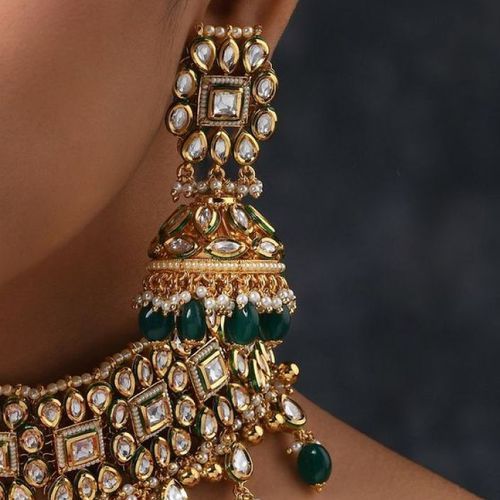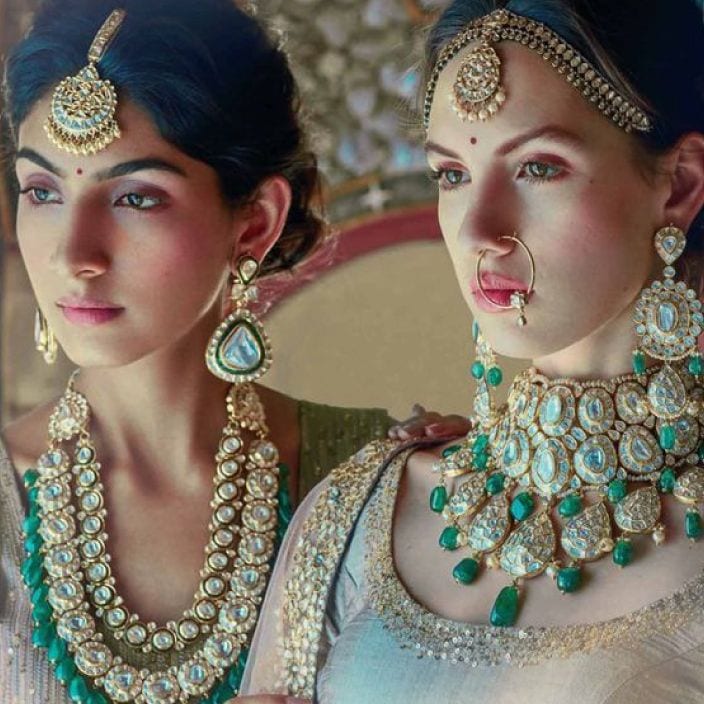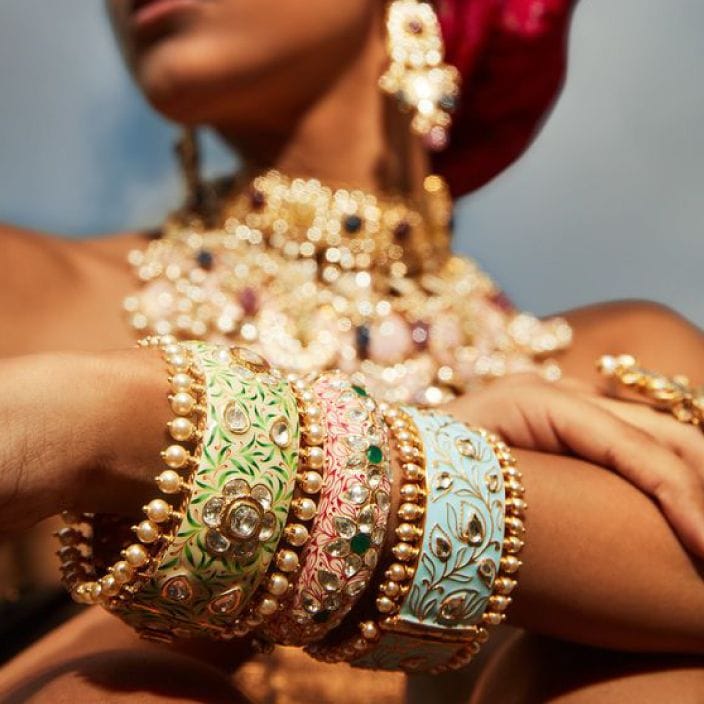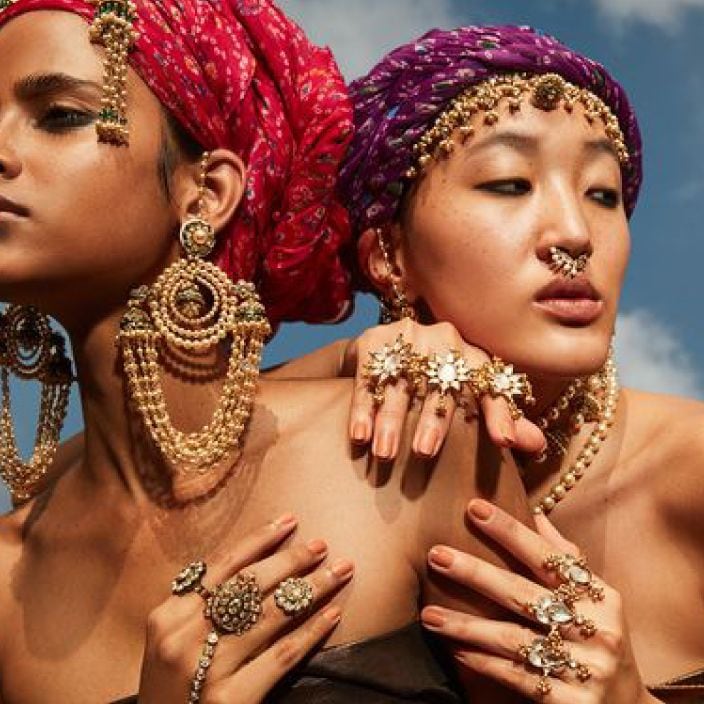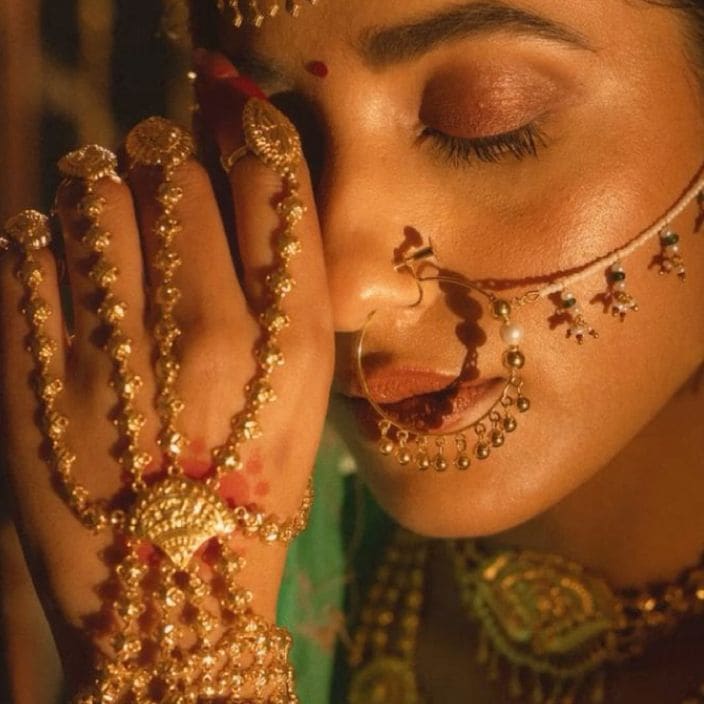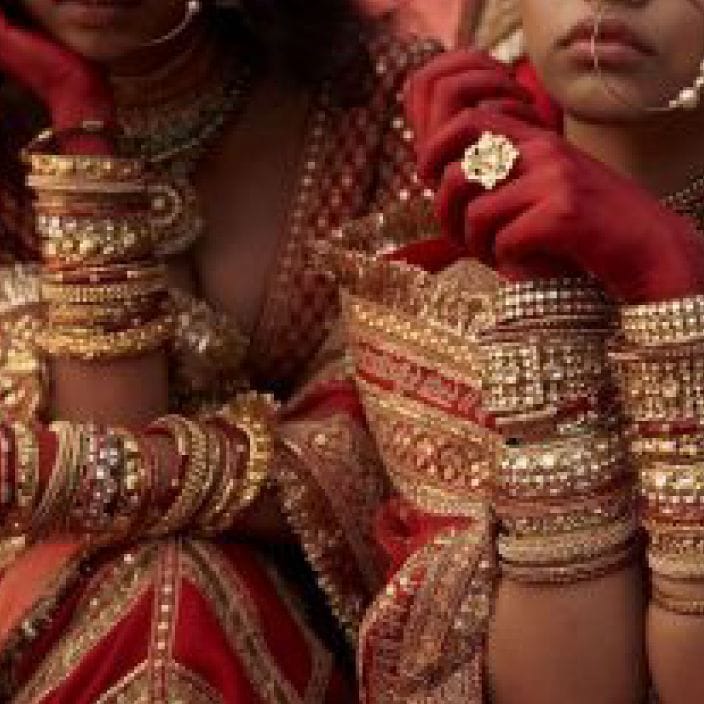For best prices and early deliveries, WhatsApp us at. 918488070070
Kundan Jewellery
Deep-rooted in the royal era of India, Kundan jewellery, also known as Kundan Keshri, Bikaneri or Jaipuri jewellery, has become an essential part of the traditional bridal wedding trousseau and heirloom collections. The term kundan, meaning highly refined pure gold, refers to the pure molten gold foil used as a mount for the gems. This hand-crafted signature style is meticulous and time-consuming. It uses the traditional Kundan jewellery making process, where gemstones are fixed without using prongs or claws. For centuries, highly skilled Kundansaz have adopted this unique gemstone setting style that involves carefully placing and pressing polished precious/semi-precious stones in individual cavities lined with a gold foil. Mostly, this type of jewellery also has a wax core. The origins and history of Kundan jewellery in India can be traced to the 3rd century BCE. The art discovered in Rajasthan flourished under the patronage of the Mughals. Over the years, the popularity grew beyond the royal robe. Today, craftsmen from Rajasthan, Bihar and Punjab are recreating Kundan jewellery in gold and silver, using the traditional thappa and ras rawa techniques. While originally, Kundan jewellery had uncut diamonds; sometimes, glass is used to cut costs. Kundan jewellery also has some common motifs. Floral patterns that represent beauty, nature, and fertility are a favourite. Different kinds of flowers, such as lotus, rose, jasmine, and tulip, are often found on different types of Kundan Jewellery such as Kundan necklaces, bangles, earrings, etc. Kundan jewellery pieces also have delicate patterns of leaves and vines, symbolising growth, prosperity, and vitality. There are also birds and animals like peacocks, parrots, and elephants that depict Indian mythology, folklore, and nature. You can even find a pretty paisley or mango pattern that is said to bring good luck and prosperity. Basically, all these motifs designs drew inspiration from architecture that prevailed in the Mughal era. Mughal-inspired arches, domes, and geometric pattern motifs are also enamelled on Kundan jewellery. The whole process or art of making kundan jewellery is called jadau. The word Jad means to be embedded. It is the coming together of Kundan (a pure gold jewellery form of setting that encases different types of kundan stones) and Polki (uncut diamonds, emeralds, rubies).
The Making of Kundan Jewellery
Depending on the intricacy of the design, the time taken to handcraft a Kundan ring, Kundan earring, Kundan kada or Kundan necklace can vary, anywhere from two to four months. Every piece has uncut diamonds, coloured gemstones or glass exquisitely designed in pure gold or faux metal base.
The elaborate process begins with finalising the design layout. The artisans then proceed to create the pattern outlining the layout of the stones called Paadh. The kaarigar then builds a framework called Ghaat or Gadhayi and fills it with lac or resin, which forms the foundation for setting the gemstones.
Next is the Pakai process, in which the gold is formed into thin gold strips or foils to hold the gems onto the base framework. The uncut diamonds (polki) or other precious stones are fitted into the grooves of the framework. This embedding stage is called Khudai. This process, also called Jadayi, involves setting the gem by inserting a gold foil between the stones and their mount.
In the next stage, called Thappa, the kaarigar presses the edges of the gold foil around the gemstones to secure the stones. The piece is then handed over to a Meenakar who does vibrant enamelling work or Meenakari on the back or inner side of the jewellery piece.
Now, the piece returns to the kaarigar, who cleans and polishes it to remove excess material and dirt. This technique of polishing the ornament is called Chillai.
Finally, the pieces are assembled together, any adjustments needed are done, and final touches applied, to complete the jewellery piece.
Cultural Significance
Kundan jewellery stands as a testament to India’s rich legacy. The intricate jewellery style once associated with royalty has become a status symbol in modern times. Here are some aspects of its cultural significance.
Kundan jewellery is a symbol of royalty and prestige. For centuries, kings and queens wore Kundan jewellery. Later, the nobility started to wear Kundan jewellery. Kundan jewellery is a status symbol.
Every piece of Kundan jewellery has artistic finesse. The fine craftsmanship of Kundan jewellery reflects India’s artistic heritage. For generations, skilled artisans have set semi-precious or precious gemstones into gold foil, creating stunning Kundan necklaces, earrings, bangles, bracelets, maang tikkas, rings and noserings.
Kundan jewellery reflects religious beliefs. Brides wear heavy Kundan ornaments from head to toe to bring good luck and prosperity. Various motifs in Kundan designs, which hold meaning in Hindu mythology, are also believed to ward off evil spirits.
Kundan jewellery also represents economic diversity. Today, Kundan jewellery is more than an ornament. It is the livelihood of thousands of artisans who work together to complete one piece of Kundan jewellery. Rajasthan’s well-established Kundan-making industry provides local jobs and earns foreign exchange for the country.
Kundan jewellery is a leader in adaptability and versatility. In a world where trends come and go, the fusion of tradition and modernity makes Kundan jewellery the perfect choice for a family heirloom. Kundan jewellery is so versatile that you can wear it on different occasions, from weddings to festivals and galas to get-togethers.
Kundan jewellery has an aesthetic appeal and is the perfect accessory to enhance the beauty of any attire. The traditional motifs handcrafted in every necklace, bangle, bracelet, and earring give it character and highlight the beauty of any bridal lehenga, salwar kameez, or saree. It is also a symbol of power and status.
Evolution & Adaption
Kundan jewellery is woven into the fabric of modern India. While the basic technique of setting gemstones in gold foil remains the same, the designs have evolved from traditional motifs to contemporary designs. Deeply connected with art, culture and history, Kundan jewellery, in these last few decades, has been experiencing a resurgence in popularity.
Also, with growing awareness for sustainability, jewellers are incorporating ethically sourced gemstones and are using alternative metals like white bronze. Transcending time and trends, every piece of Kundan jewellery has a story to tell.
